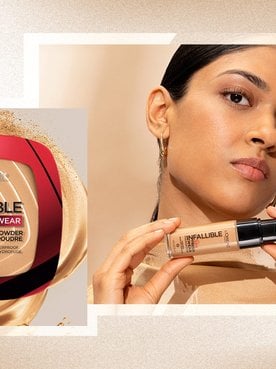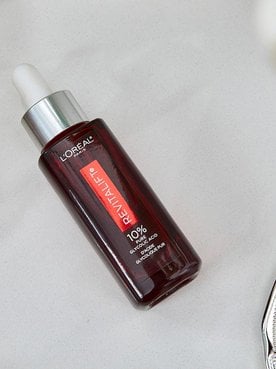Highlighter FAQs
What Is a Face Highlighter?
What Is a Body Highlighter?
Where Should I Apply Highlighter?
How Should I Apply a Highlighter on My Face?
To apply highlighter on your face, focus on the areas where light naturally hits and where you want to enhance brightness and dimension. These key areas include:
• Cheekbones: Apply highlighter above your blush, sweeping from the top of your cheekbones towards your temples in a C-shape.
• Brow Bone: A small touch of highlighter just under the arch of your eyebrow can lift and open the eye area.
• Inner Eye Corners: A dab of highlighter here instantly brightens your eyes and makes you look more awake.
• Bridge of Nose: A thin line of highlighter down the center of your nose can make it appear straighter and more defined. Avoid the tip if you don't want to draw attention there.
• Cupid's Bow: A tiny touch of highlighter on the dip above your upper lip can make your lips appear fuller.
Tips for Different Highlighter Formulas:
• Liquid Highlighters: Liquid highlighters like True Match Lumi Glotion offer a dewy, natural glow. They blend beautifully with liquid foundations; you can mix a drop into your foundation for an all-over luminous finish, or dab onto targeted areas and blend with your fingers, a damp sponge, or a synthetic brush.
• Cream/Stick Highlighters: Stick highlighters like Lumi Le Glass Glow Highlighter Stick provide a more intense, buildable glow. Apply directly to your skin, then blend out with your fingertips or a dense brush. Like liquids, these work best applied before powder.
• Powder Highlighters: Powder highlighters like Infallible Up to 24HR Longwear Powder Highlighter deliver a more diffused but buildable shimmer. Use a fluffy brush (like a fan brush or a small fluffy blush brush) to lightly dust onto desired areas after your foundation and setting powder. Powder highlighters are great for layering over cream or liquid products after setting for extra intensity.
Always remember to blend well to avoid harsh lines and achieve a seamless, natural-looking glow. Start with a small amount and build up if you desire more intensity. For more tips, check out our guide to how to apply highlighter.What Are the Different Types of Highlighters?
Highlighters come in various formulations, each offering a distinct finish and application experience:
• Powder Highlighters: Powder highlighters are the most common type, available in pressed or loose forms. They offer a versatile range of finishes, from subtle sheen to intense shimmer, and are typically applied with a brush. Powder highlighters are great for setting cream products and providing a long-lasting glow.
• Liquid Highlighters: Offering a more natural, dewy, and luminous finish, liquid highlighters can be mixed with foundation for an all-over glow or dabbed onto specific areas for targeted radiance. They blend seamlessly into the skin, making them ideal for a "lit-from-within" look.
• Cream Highlighters: Cream highlighters provide a creamy, often buildable, and natural glow. They can be applied with fingertips, a sponge, or a brush, melting into the skin for a seamless finish. Cream highlighters, like the Lumi Le Glass Highlighter, are excellent for dry skin types and for achieving a hydrated, healthy-looking sheen.
• Stick Highlighters: Convenient and portable, stick highlighters are solid cream or gel formulas in a twist-up tube. They offer easy, direct application and are perfect for on-the-go touch-ups, providing a targeted and often intense shimmer.
How Do I Choose the Right Highlighter Shade for My Skin Tone?
Choosing the right highlighter shade depends on both your skin tone and undertone to ensure a seamless, natural, and radiant glow.
• Fair Skin Tones: For very fair to light skin, opt for highlighters with a pearlescent, champagne, or iridescent pink tint. These shades complement the cool or neutral undertones often found in fair skin, providing a delicate, ethereal luminosity without looking too stark or golden. Avoid anything too dark or bronze, which can appear muddy.
• Medium Skin Tones: Medium skin tones can beautifully wear a wider range of shades. Golden, peach, or warm champagne highlighters work wonderfully to enhance warmth. If you have cooler undertones, a rose gold or subtle pink champagne can be flattering. These shades add a healthy, sun-kissed radiance.
• Olive Skin Tones: Olive skin, which often has green or yellow undertones, looks stunning with golden, bronze, or copper highlighters. These warm, rich tones complement the natural warmth in olive skin, giving a gorgeous, sunlit glow. Avoid very cool-toned or stark white highlighters that might appear ashy.
• Deep Skin Tones: For deep skin tones, rich bronze, copper, or intense gold highlighters are incredibly flattering. Shades with red or orange undertones, like true copper or deep rose gold, can truly pop and add a luxurious, radiant dimension. Avoid lighter, silvery shades that can look chalky; instead, focus on high-impact, luminous finishes that melt into the skin.
Regardless of your skin tone, consider your undertone:
• Cool Undertones (pink, red, blue): Look for highlighters with silvery, icy pink, or cool champagne tones.
• Warm Undertones (yellow, golden, peach): Opt for golden, bronze, or peach-toned highlighters.
• Neutral Undertones: You can usually pull off a wide range of shades, but champagne and rose gold are often very flattering.
For more guidance, check out our article on the best highlighter for every skin tone.Can I Use Highlighter Without Foundation?
Yes, you can use highlighter without foundation for a fresh, natural, and radiant look. Applying highlighter directly to bare skin or over a light base like tinted moisturizer or primer can give you a beautiful, "no-makeup makeup" glow.
Here are some tips for applying highlighter without foundation:
• Prep Your Skin: Ensure your skin is well-hydrated and moisturized. This creates a smooth canvas for the highlighter and helps it blend seamlessly.
• Focus on Key Areas: Apply highlighter sparingly to the high points of your face where light naturally hits such as your cheekbones, brow bone, inner corners of your eyes, and Cupid's bow.
• Choose the Right Formula:
◦ Liquid or Stick Highlighters: These are often best for a natural look on bare skin as they tend to melt in and provide a dewy finish without looking powdery. Apply with your fingertips and gently tap or pat to blend.
◦ Powder Highlighters: If using a powder, apply with a very light hand using a fluffy brush to avoid harsh lines.
• Blend, Blend, Blend: Blending is crucial to avoid harsh lines and ensure the glow looks natural and integrated into your skin.
• Less is More: When going foundation-free, a subtle application is best for a natural, healthy-looking radiance.
How Do I Make My Highlighter Last Longer?
Is There a Difference Between Highlighter and Illuminator?
While both highlighters and illuminators are designed to add radiance to the skin, they serve slightly different purposes and achieve different effects.
• An illuminator typically provides an all-over, more diffused glow. It often has a finer shimmer or a pearlescent finish and is designed to make the skin look generally healthy, luminous, and radiant. Illuminators are frequently used as a base, mixed with foundation, or applied all over the face before other makeup to give a "lit-from-within" glow.
• A highlighter is used more strategically to emphasize specific features by reflecting light. It usually contains more concentrated shimmer or sparkle and is applied to the high points of the face (like cheekbones, brow bones, etc.) to create dimension and a more focused, intense highlight.
You can use both illuminator and highlighter together for an amplified, multi-dimensional glow: apply an illuminator or illuminator-highlighter hybrid like Lumi Glotion first as a radiant base to achieve overall luminosity, then use a highlighter on specific points to create a more targeted, striking glow. Learn more about the difference between illuminator and highlighter.






